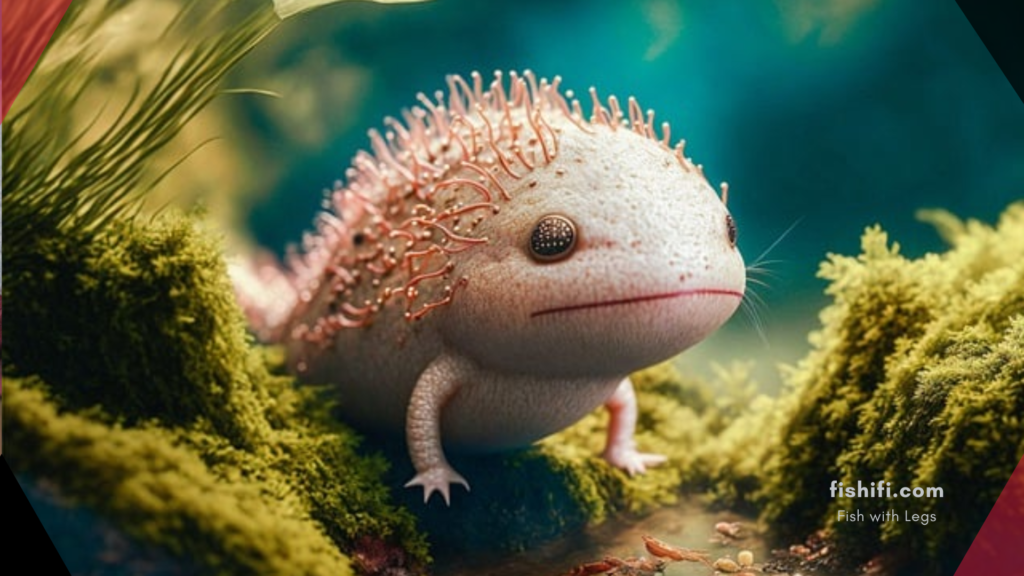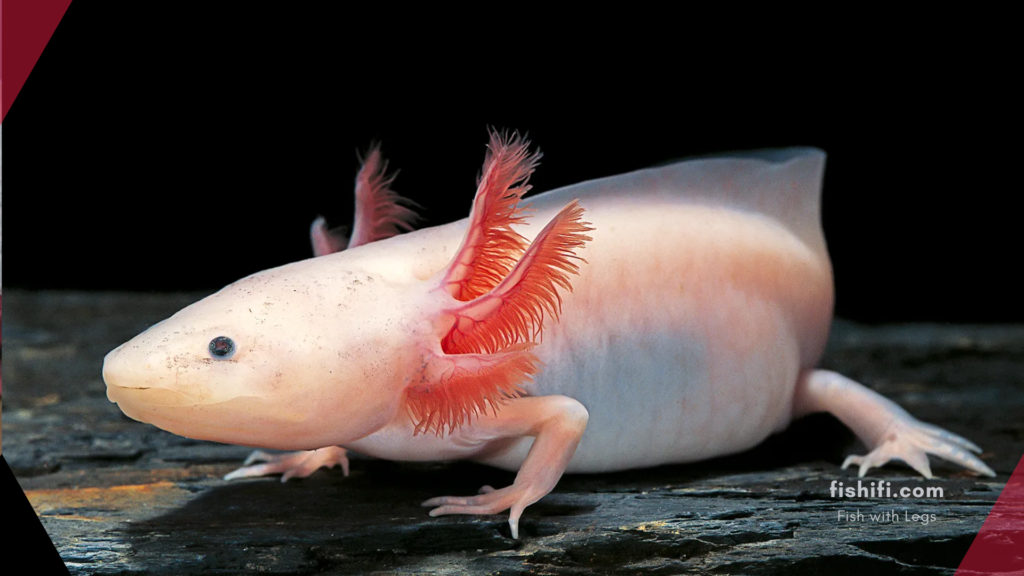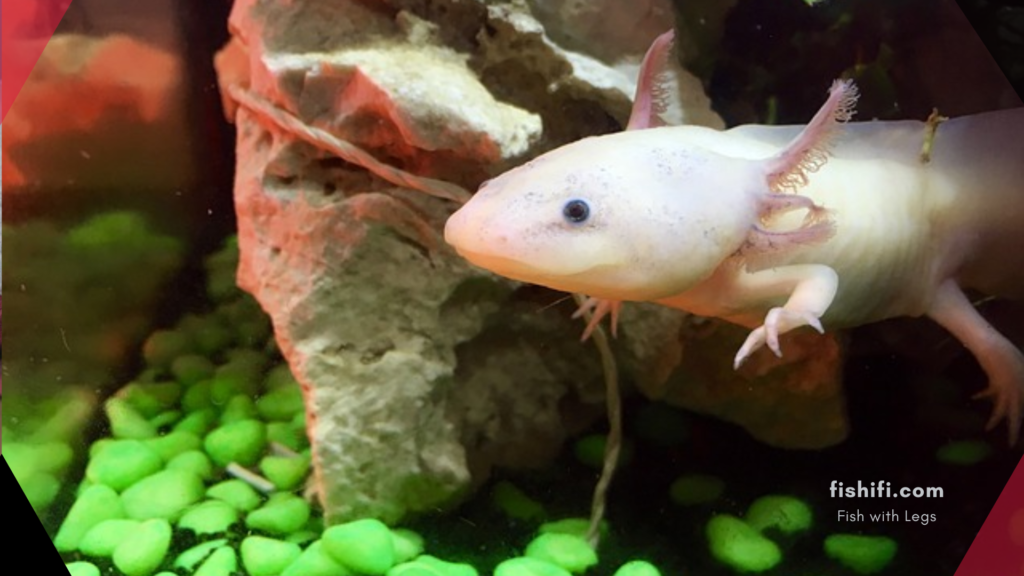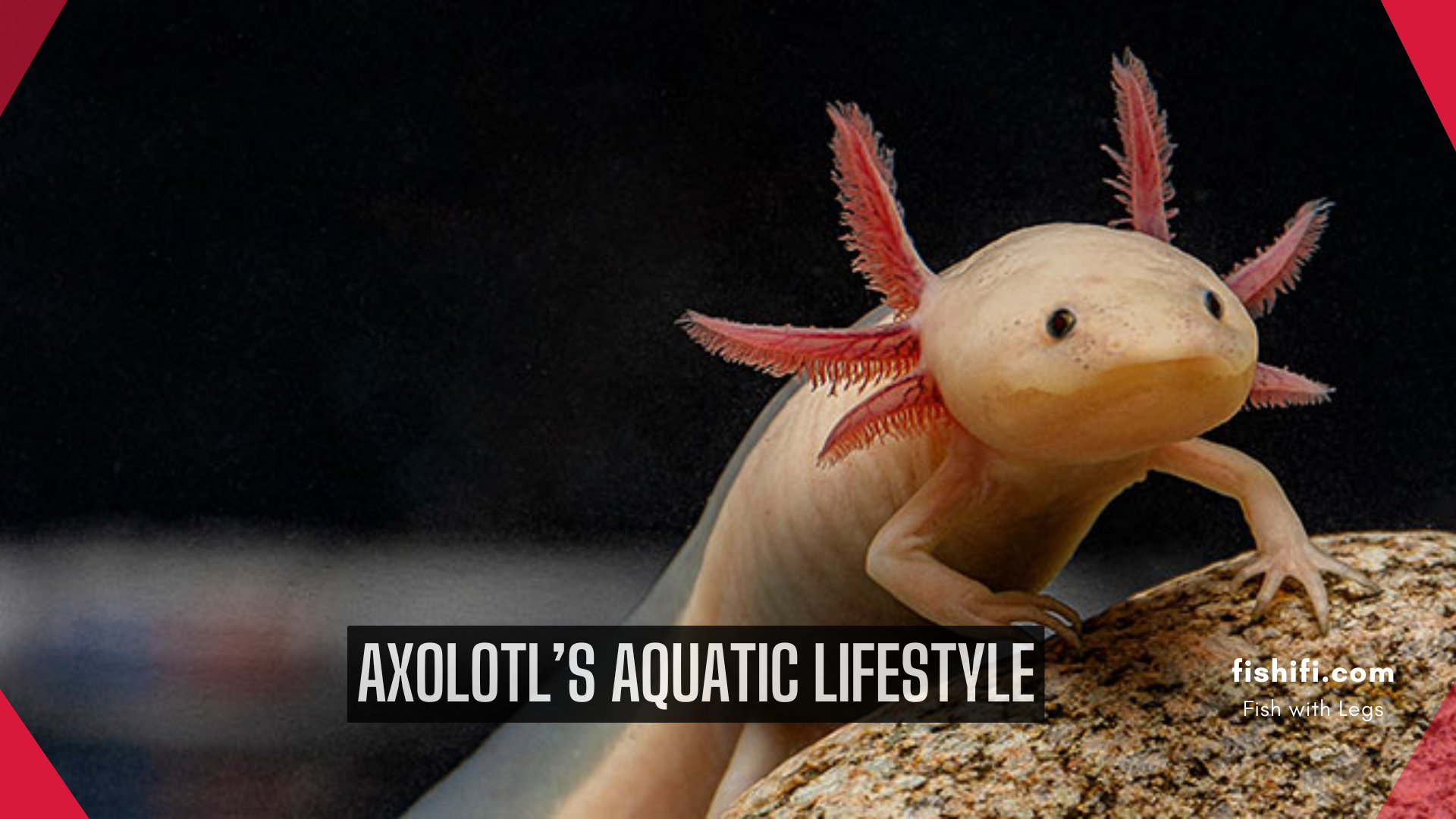Axolotls are truly amazing creatures! Many people wonder, Can axolotls go on land? The simple answer is no, they can’t. However, there is so much more to know about these incredible animals. People often describe them as little underwater dragons because of their unique and magical appearance. They are popular among pet owners and scientists who love studying them because of their fascinating features.
Axolotls, also known as the Mexican walking fish, are a type of fish Unlike many amphibians that have transitioned from aquatic to terrestrial environments during their lifecycle, axolotls remain aquatic their entire lives. This unique characteristic is directly related to their specialized anatomy and evolutionary adaptations.
Table of Contents
The Key to Axolotl’s Aquatic Lifestyle
Axolotls are unique among amphibians because they exhibit a condition called neoteny. Neoteny means that axolotls retain many juvenile or larval traits throughout their lives. Most salamanders undergo metamorphosis, losing their gills, developing lungs for breathing air, and transitioning to living on land—axolotls, however, never fully metamorphose.
This lack of full development allows them to keep their external gills for extracting oxygen from water. These feathery gills extend outward from the sides of their head and are highly efficient at drawing oxygen from the water surrounding them. Without these gills, axolotls would struggle to breathe efficiently in their aquatic habitat.

Body Structure: Adapted for Aquatic Movement
While axolotls have lungs, still the question arises Can Axolotls Go on Land, the answer is they are not designed to support life outside water for extended periods. Their lungs are underdeveloped compared to other land-dwelling amphibians. Axolotls mainly depend on their gills and skin to breathe.
Axolotls are physically built to move and live in water. Their body is streamlined, with a long, flat tail that provides powerful propulsion for swimming. Their limbs are relatively weak and not adapted for supporting their weight on land. Unlike fully terrestrial salamanders, which develop stronger, sturdier legs, axolotls maintain the delicate, webbed structure of their limbs, which are ideal for gentle movements in water.
Their skeletal structure further underscores their aquatic adaptation. Axolotls have a cartilaginous skeleton that remains relatively soft and pliable throughout their lives. On land, this would make it difficult for them to bear their body weight or move efficiently.
Respiratory System – Can Axolotls Breathe Air?
Axolotls are fascinating creatures known for their extraordinary appearance and unique biological features. One question many people have is whether these aquatic animals can breathe air. The short answer is yes—axolotls can breathe air, but their primary way of obtaining oxygen is through other methods. To fully understand how axolotls breathe, one must know about their specialized respiratory system and the unique adaptations that allow them to survive and thrive underwater while breathing air when needed.
Three Ways Axolotls Breathe
Axolotls are amphibians, and like many others in their group, they have multiple ways to extract oxygen:
3. Gills – Primary Respiratory Organ
Axolotls have external gills that protrude from the sides of their heads like feathery branches. These gills are their primary way of breathing. They function by absorbing oxygen from the water that flows over them. The gills are rich in blood vessels, which makes them highly efficient at exchanging gases. Axolotls spend most of their time submerged in water, and their gills ensure they get enough oxygen to survive.
2. Skin – Cutaneous Respiration
Axolotls can also breathe through their skin, known as cutaneous respiration. Their skin is thin and highly permeable, allowing oxygen to diffuse directly into their bloodstream from the surrounding water. This respiration method is particularly useful in oxygen-rich waters and acts as a supplementary breathing mechanism. However, the efficiency of this method depends on the cleanliness and oxygenation of the water.
3. Lungs – Air-Breathing
Axolotls possess small, less-developed lungs that allow them to breathe air. Occasionally, you may observe an axolotl rising to the surface of the water and gulping air. This behavior is more common in low-oxygen conditions when their gills and skin can’t supply enough oxygen. The lungs act as a backup system, allowing them to take in additional oxygen as needed. Despite having lungs, axolotls are not well-adapted to live out of water and can only survive briefly on land.
Why Do Axolotls Surface for Air?
Although axolotls primarily rely on their gills and skin for respiration, their ability to use lungs plays an essential role in certain situations. For example
- Low Oxygen Levels in Water
If the water becomes poorly oxygenated due to stagnation or pollution, axolotls may rely more on their lungs to meet their oxygen needs. - Natural Behavior
Even in well-oxygenated water, axolotls may occasionally surface to gulp air. This behavior could also serve other physiological purposes, such as adjusting buoyancy. - Lung Structure and Efficiency
Axolotl lungs are less efficient compared to other amphibians that spend more time on land. Their lungs are relatively small, simple sacs rather than the complex, highly vascularized structures seen in mammals or terrestrial amphibians. - Adaptations for Aquatic Life
While axolotls can breathe air when necessary, their bodies are primarily designed for an aquatic lifestyle. They’ve evolved to rely on gills and cutaneous respiration for most of their oxygen needs. The occasional use of lungs is a survival mechanism rather than a preferred method for respiration.

Axolotls Dos and Don’ts: A Detailed Guide to Proper Care
Axolotls are fascinating and unique pets that require specialized care to thrive. As aquatic creatures with delicate bodies and specific environmental needs, understanding the dos and don’ts of their care is essential for their health and happiness. Here’s a detailed breakdown of what you should and shouldn’t do when caring for your axolotl.
Essential Practices for Axolotl Care
- Do Keep Their Water Clean
Axolotls live and breathe in water, making cleanliness a top priority. Regularly test the water for proper pH (6.5–7.5), temperature (60–68°F or 15–20°C), and ammonia levels (0 ppm). Perform water changes weekly, replacing 20–30% of the water to remove harmful toxins. - Do Provide a Spacious Tank
Axolotls need enough space to swim comfortably. A minimum tank size of 20 gallons is recommended for one axolotl, with an additional 10 gallons for each extra axolotl. Larger tanks can keep water quality stable. - Do Use a Gentle Filter
Axolotls prefer still or slow-moving water. Use a gentle, quiet filter to avoid creating strong currents that can stress them. Sponge filters or canister filters with adjustable flow rates are excellent choices. - Do Create Hiding Spots
Axolotls love to explore and feel safe. Provide hiding places in their tank, such as caves, pipes, or plants. These give them a sense of security and reduce stress. - Do Feed Them the Right Diet
Offer your axolotl a varied diet that includes high-quality pellets, earthworms, bloodworms, or frozen food designed for aquatic amphibians. Feed them 2–3 times a week, and remove any uneaten food to maintain water quality. - Do Handle Them Gently When Necessary
If you must move your axolotl—for example, during a tank cleaning—use a soft, fine-mesh net to support the body gently. Avoid sudden movements that might frighten them.
Common Mistakes to Avoid
- Don’t Take Them Out of the Water
Axolotls are fully aquatic animals and cannot survive outside water for extended periods. Taking them out can cause stress, damage their delicate skin, and dehydrate them quickly. - Don’t Use Small or Sharp Substrate
Avoid using gravel or sharp substrate in their tank, as axolotls may accidentally ingest it, leading to blockages in their digestive system. Instead, opt for fine sand or bare-bottom tanks for safety. - Don’t Keep Them with Tankmates
Axolotls are solitary creatures that can’t exhibit territorial behavior. Keeping them with other fish or amphibians can lead to injuries, stress, or aggression. - Don’t Use Bright Lighting:
Axolotls dislike bright lights, as they lack eyelids and are sensitive to intense illumination. Use dim lighting and consider providing shaded areas in their tank. - Don’t Overfeed Them
Overfeeding can disturb water quality. Monitor portion sizes and avoid offering food too frequently. A well-fed axolotl will maintain a healthy weight without leftover food in the tank. - Don’t Use Strong Chemicals for Cleaning
Harsh cleaning products or unconditioned tap water containing chlorine can harm your axolotl. Always treat tap water with a water conditioner to remove harmful chemicals before adding it to the tank.
Axolotl Care: A Step-by-Step Detailed Guide
Axolotls, need the best care to survive. Let’s know every aspect of axolotl care, explained in simple yet comprehensive steps.
Step 1: Setting Up the Tank
Creating a safe and suitable habitat is crucial for your axolotl’s health and well-being.
- Tank Size
A single axolotl requires a minimum tank size of 20 gallons to swim comfortably.
For each additional axolotl, add 10 gallons to ensure sufficient space. Larger tanks help dilute waste and stabilize water conditions. - Substrate – Tank Bottom
Use fine sand or leave the tank bottom bare. Bare-bottom tanks can be easily cleaned and the risk of accidents can be prevented.
Avoid gravel or small pebbles because axolotls may ingest these during feeding, leading to intestinal blockages. - Hiding Spots and Decor
Axolotls are shy animals that thrive when they have places to hide. Use caves, PVC pipes, or aquarium-safe decor. Include live or artificial plants for natural aesthetics and comfort. Ensure decorations are free from sharp edges that can cause injuries to your axolotl’s soft skin. - Lighting
Use low-intensity, dim lighting to mimic their natural habitat. Bright lights stress axolotls, as they lack eyelids to shield their eyes. Opt for adjustable lighting with timers for a natural day-night cycle. - Tank Placement
Position the tank in a quiet, shaded area away from direct sunlight and vibrations. Excessive noise or motion can cause stress.
Maintaining Water Quality
Axolotls are aquatic animals that rely on stable, clean water conditions for survival.
- Water Temperature
The ideal water temperature is between 60°F and 68°F (15°C to 20°C). Use an aquarium thermometer to monitor temperature daily. For warmer climates, invest in a water chiller to prevent overheating, as high temperatures can stress and harm axolotls. - Water Parameters
pH Levels: Maintain a range of 6.5 to 7.5 (neutral to slightly alkaline). Ammonia must be at 0 ppm (parts per million and Nitrates Should be kept below 20 ppm. Use a liquid testing kit for accurate results. - Filtration
Choose a gentle filter that creates minimal current, such as sponge filters or adjustable canister filters. Strong currents stress axolotls and make it difficult for them to swim. - Weekly Water Changes
Replace 20–30% of the tank water weekly with clean, dechlorinated water. Dechlorinate tap water using a water conditioner before adding it to the tank. Use a siphon to remove waste and uneaten food from the substrate.
Step 3: Feeding Your Axolotl
Axolotls are carnivorous and need a high-protein diet to grow and stay healthy.
- Recommended Foods
High-quality, sinking axolotl pellets. Live or frozen foods like Earthworms, Bloodworms, or blackworms. - Feeding Schedule
Juveniles: Feed once a day to support growth.
Adults: Feed 2–3 times per week, a full belly is slightly rounded but not bloated. - Feeding Tips
Use feeding tongs for frozen or live food to avoid contaminating the tank. Remove uneaten food within 15 minutes to maintain water quality and prevent ammonia spikes.
Step 4: Handling and Interaction
Handling axolotls must be minimized due to their delicate bodies and sensitive slime coats.
- Avoid Direct Handling
Axolotls have soft, slippery skin protected by a slime layer, which shields them from infections. Handling them can damage this layer. If handling is necessary ensure wet, clean hands or use a soft net to minimize harm. - Using a Soft Net
Soft aquarium nets are essential for safely moving your axolotl when cleaning or transferring to a temporary container.

Step 5: Observing and Monitoring Health
Pay close attention to your axolotl’s behavior and physical appearance to identify any signs of illness.
- Signs of a Healthy Axolotl
Bright, feathery gills with no discoloration. Smooth skin free from white spots or sores. Active and responsive behavior during feeding times. - Common Health Problems
Gill Damage Caused by poor water quality or aggressive tankmates. Fungal Infections Appear as cotton-like growths on the skin. Lethargy or refusal to eat can indicate a problem. Consult a vet with experience in amphibians if you notice any issues.
Step 6: Routine Maintenance
Keeping a clean tank is vital for your axolotl’s health and overall environment.
- Daily Tasks
Check the water temperature and filter operation. Remove uneaten food promptly. - Weekly Tasks
Test water for pH, ammonia, nitrites, and nitrates. Perform partial water changes to maintain optimal conditions. - Monthly Tasks
Clean the filter media using tank water to preserve beneficial bacteria—scrub tank decorations and walls to remove algae growth.
Step 7: Choosing the Right Tankmates
Axolotls are best kept alone, but if you decide to add companions, consider these points.
- Compatibility
Avoid small fish—they may nip at axolotl gills, and the axolotl may eat them.
Avoid aggressive or territorial species. - Axolotls Together
If multiple axolotls are being housed, ensure they are of similar size to prevent bullying or cannibalism.
Provide enough space, hides, and food to minimize competition.

